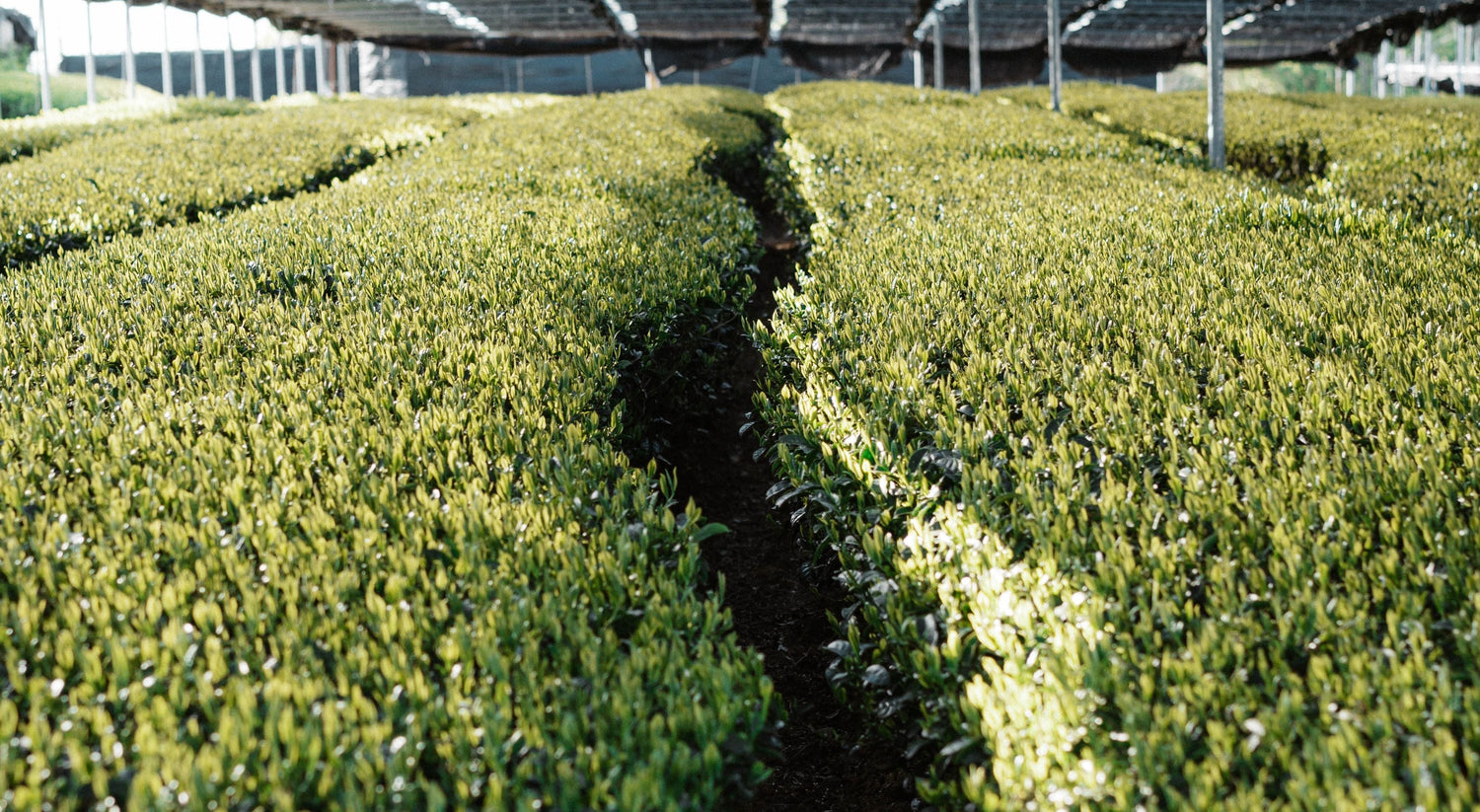Be it a robust black tea or a gentle green tea, there's nothing quite like enjoying an aromatic cup of tea with loved ones, sitting together and creating unforgettable moments! But did you know that all teas come from the same tea plant? That's right, the various types of teas with their multifaceted aroma are solely the result of different processing methods applied to the tea leaves. One important process is oxidation. How does it work? Let's look behind the scenes of tea production together.
- What is the Camellia Sinensis Plant?
- One Plant, Six Types of Tea
- Tea Production: The Different Processing Methods
- The Art of Minimal Processing: How White Tea is Made
- The Demanding Processing of Green Tea
- A Well-Kept Secret: The Production of Yellow Tea
- The Perfect Balance of Partial Oxidation: Oolong Tea
- How Black Tea is Made
- Pu-Erh: The Tea that Ages Gracefully
- The Magic of Tea Production
What is the Camellia Sinensis Plant?
Our beloved tea is made from tender leaves and buds of the Camellia Sinensis tea plant, which belongs to the Camellia genus. In most tea gardens it is pruned down to about 1.5 meters. However, in the wild, these trees can grow up to 18 meters high. The name "Sinensis" derives from its original Chinese origin, but the tea plant finds ideal growing conditions in many regions of the world. In tropical highlands, a combination of high humidity and warm daytime temperatures that cool down at night creates the optimal climate for the plant to thrive. It favors water-rich misty forests and rough highlands. Thus, Camellia Sinensis can be found in India, Japan, Sri Lanka, Korea and Southeast Asian countries like Taiwan, Laos, and Myanmar, but also in Chile, Thailand, Vietnam, Indonesia, Colombia, Kenya and other regions with humid highlands.

One Plant, Six Types of Tea
The given conditions in various terrains, be it ideal soil composition, sunlight, rainfall and altitude, play a decisive role in the flavor of the tea. Working with all these climatic factors, skillful processing methods influence the diverse aromas in the cup. The nuances of individual types of tea emerge through different production processes, craftsmanship traditions, shading, and the timing of the harvest right after picking. All six classic types of tea - white tea, green tea, yellow tea, oolong, black tea and pu-erh - are produced from Camellia Sinensis. By nature, each tea leaf contains caffeine. It's a common misconception that black tea has more caffeine than other teas. The caffeine strength in tea depends on the growing region's climatic conditions and processing methods. In contrast, herbal tea is only a tea-like beverage. Whether chamomile tea, mountain herb tea or ginger tea, they come from plants other than the tea plant. This doesn't make them any less delicious; however, they are technically not considered true teas but herbal infusions.

Tea Production: The Different Processing Methods
For decades, delicious tea has been made from tea leaves. Several times a year, whole leaves are harvested and gathered either mechanically or by hand. All six types of tea come from the same tea plant; which type will result from the freshly picked tea leaves and buds depends on the respective processing methods. Here are the main principles of tea production:
- First, the leaves are laid out in the sun to wither, removing moisture and preparing them for the subsequent processes. However, this step is skipped for green tea.
- Oxidation is the chemical process that describes the reaction with oxygen. During tea production, tea leaf oxidation is stimulated by breaking the leaf cells. For example, oolongs are shaken in baskets during processing and tea leaves for black teas are crushed and rolled. Upon opening the plant cells, they naturally react to the surrounding air and begin to change color. This process is akin to the browning of a sliced apple left out. Depending on the duration, the oxidized leaves turn dark, reddish-brown to black. Black teas are fully oxidized, while oolongs have an oxidation range of 30 to 80%.
- Fixation does the opposite: oxidation of the tea is stopped by heat. For green tea, fixation occurs immediately after plucking to preserve the green color of the tea leaves. Partially oxidized oolongs are also fixed with heat after reaching a certain degree of oxidation.

- To complete the process, the tea leaves must be dried. The drying process varies depending on the type of tea. Some teas are shaped and rolled, like oolong teas and some white teas.
- The tea is sifted into various grades and prepared for packaging in special machines with different fine mesh inserts. Tea grades are sorted by leaf size: whole-leaf teas are the most precious and highest quality, as the tea leaves remain intact. Broken teas are parts of tea leaves, usually machine processed. Fannings are remnants after sifting broken teas and are used for tea bags. Dust tea is the smallest leaf grade, serving as filler material for tea bags.
- Fermentation is a microbiological process through which Pu-erh tea is produced. The tea leaves are covered and microorganisms are introduced, which mature over time. A distinction is made between slowly fermented teas, Sheng Pu-erhs (natural fermentation), and a modern, faster process (controlled fermentation) used for Shou Pu-erh teas.
The Art of Minimal Processing: How White Tea is Made
White tea is the least processed tea variety. This tea uses particularly young leaves and fine buds, giving it an incomparable delicate flavor. After picking, the tea leaves are laid out in the sun. This means that white tea is primarily dried and only slightly oxidized. This natural process maintains the leaf structure significantly. Thus, the fine hairs on the leaves, which give white tea its name, also remain. You can see this in our PU ER BAI YA N°103. White tea shows us the magic and flavor that can be found in simplicity.

The Demanding Processing of Green Tea
Green tea is the largest tea family. The biggest difference between black tea and oolong is that the tea leaves must not wither immediately after harvest. The reaction with oxygen is prevented by heat fixation. In other words, green teas are non-oxidized teas. The tea leaves then undergo heat treatment. There is the Japanese method, where the tea leaves are treated with moist heat, i.e., with hot steam, and the Chinese method with dry heat, where the tea leaves are roasted in a kind of pan. This creates a wide range of fantastic flavors.
Green teas in the Japanese tradition taste hearty, juicy and umami, such as our Sencha MIGHTY GREEN N°319. Chinese green teas are rather sweet and lovely like our IMPERIAL DRAGON N°302. The non-oxidation of the tea leaves preserves the green color. Matcha tea is a long-shaded green tea. The tea fields are covered with nets so that only a small amount of sunlight reaches the plants. This gives the tea leaves an intense green color and a pleasant sweetness in flavor. Usually shading begins 3-5 weeks before harvest. Matcha is then ground into a fine powder in mills. 
A Well-Kept Secret: The Production of Yellow Tea
To enjoy this rare tea variety, a meticulous process of heating and resting is required. The processing is like green tea, but the tea leaves are roasted at a lower temperature and then sealed. For sealing, the tea leaves are wrapped in a special cloth and left to rest, allowing oxidation to occur without oxygen. This is also referred to as "smothered tea." The production of yellow tea dates to a long Chinese tradition and it remains a secret held by tea masters on how to create the perfect yellow tea. Our LEIZU'S GOLDEN SILK N°202 invites you into the mysterious world of yellow tea.
The Perfect Balance of Partial Oxidation: Oolong Tea
The production of oolong teas is a balancing act of oxidation levels: oolongs are partially oxidized on a spectrum of 20% to 80%. To initiate oxidation after harvest, tea leaves are shaken on large trays until the process is prematurely halted with heat, unlike black teas. There are lightly oxidized green oolongs like FOUR SEASONS OF SPRING N°402 and more robust black oolongs like ORIENTAL BEAUTY N°403. Then the leaves are rolled, giving them a larger volume. When brewing oolongs, they slowly unfurl in the water, which affects the flavor: with each infusion, a new layer of complex aromas emerges.

How Black Tea is Made
Black tea is fully oxidized. After the tea leaves are laid out to wither, they are crushed to open their leaf structure and stimulate oxidation. With full oxidation of 80% or more, the tea leaves also darken to black, giving the tea its name. A known procedure is the CTC method ("Crush, Tear, Curl"), to expedite the oxidation process. Subsequently, black tea is dried and sorted into leaf grades.
Pu-Erh: The Tea that Ages Gracefully
Pu-Erh tea is fermented, meaning it matures over years under regular inspection into a flavorful gem. Unlike chemical oxidation, fermentation is a biological process. Pu-Erh tea, also known as dark tea, is first piled up, covered, and must be turned regularly until maturity. Adding water stimulates microbial activity. There are two types of Pu-Erhs: traditional production with natural fermentation, which takes several years, producing our WILD & RAW N°602, and accelerated fermentation, using a modern process that speeds up the aging process. Shou Pu-Erh is ready to be enjoyed without additional aging time. Try the taste of our VINTAGE LOTUS N°601. Typically, Pu-Erh teas are pressed into round cakes, dry-stored and then sold. Pu-Erhs are almost infinitely durable.
The Magic of Tea Production
Would you have thought that all six types of tea come from the same plant? The variety of all tea types and variations arise from carefully developed production methods and processing techniques of the tea leaves. Besides extensive withering and drying processes, chemical oxidation, fixation and microbial fermentation play a decisive role in determining which tea will be made from the freshly picked harvest. Some countries have specialized in producing certain types of tea, such as Taiwan with oolongs or Japan with green teas. But alongside traditional tea gardens, innovative novelties are emerging, challenging conventions and reinterpreting methods, like our SILVER SINDANO N°106, an exciting white tea specialty in the style of silver needle tea, a novel interpretation of Chinese tea from African terrain. Whichever tea you prefer, we owe these moments of enjoyment to all the producers who dedicatedly and expertly craft tea.























